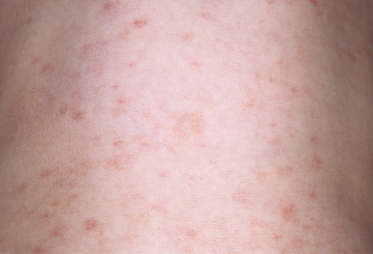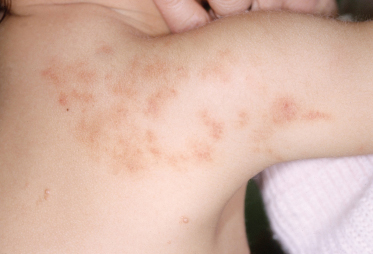Fig. 165.2 Close-up of the torso of the child in Fig. 165.1. Petechiae (‘cayenne pepper’ spots) are present at the periphery and within the lesions in Schamberg disease.

Fig. 165.3 Segmental distribution of Schamberg disease in a 3-year-old Asian girl (molluscum inferior to the eruption are an incidental finding).

Prognosis.
Although this disorder is not associated with systemic disease, it is a distressing condition because of the cosmetically disfiguring nature of the eruption. Schamberg disease has a chronic course marked by phases of resolution and recurrence. It is notoriously resistant to treatment. Lesions may clear within a few months or may persist for as long as 40 years.
Differential Diagnosis.
Progressive pigmented purpura may be thought to be purpura or ecchymoses. Platelet disorders (decrease in number or functions), coagulopathies, vasculitis, Henoch–Schönlein purpura, cryoglobulinaemia and drug eruptions are included in the differential diagnosis. The lesions in Schamberg disease are macular and never palpable, in contrast to those seen in leucocytoclastic vasculitis. Chronic hyperpigmentation is not a typical feature of Henoch–Schönlein purpura. Referrals to haematologists or rheumatologists are not necessary.
Treatment.
Unfortunately, there is no highly effective treatment for this condition. Time, patience, education and reassurance are the keys to management. PUVA and NB-UVB have been shown to be effective in some cases [14,15] but PUVA therapy should be restricted to (older) adults only. The effects of phototherapy may be related to the involvement of Langerhans cells. Therapies that have been recommended but with variable success include ascorbic acid, antihistamines, topical and systemic corticosteroids and support stockings. Although systemic corticosteroids may be the most effective of all therapies, the disease tends to recur when the medication is discontinued. Additionally, it is questionable whether systemic corticosteroids should be prescribed for a chronic benign condition [16].
References
1 Schamberg JF. A peculiar progressive pigmentary disease of the skin. Br J Dermatol 1901;13:1–5.
2 Kingery LB. Schamberg’s progressive pigmentary dermatosis: report of a case with histologic study. J Cutan Dis 1918;36:166–72.
3 Iwatsuki K, Aoshima T, Tagami H. Immunofluorescence study in purpura pigmentosa chronica. Acta Derm Venereol 1980;60:341–70.
4 Aiba S, Tagami H. Immunohistologic studies in Schamberg’s disease: evidence for cellular immune reaction in lesional skin. Arch Dermatol 1988;124:1058–62.
5 Simon M Jr, Heese A, Gotz A. Immunopathological investigations in purpura pigmentosa chronica. Acta Derm Venereol 1989;69:101–4.
6 Abeck D, Gross GE, Kuwert C et al. Acetaminophen-induced progressive pigmentary purpura (Schamberg’s disease). J Am Acad Dermatol 1992;27:123–4.
7 Draelos ZK, Hansen RC. Schamberg’s purpura in children: case study and literature review. Clin Pediatr 1987;26:659–61.
8 Von den Driesch P, Simon M. Cellular adhesion antigen modulation in purpura pigmentosa chronica. J Am Acad Dermatol 1994;30:193–200.
9 Burrows NP, Jones RR. Cell adhesion molecule expression in capillaritis. J Am Acad Dermatol 1994;31:826.
10 Lever WF, Schaumburg-Lever G (eds). Histopathology of the Skin, 7th edn. Philadelphia: JB Lippincott, 1990: 192–3.
11 Hersh CS, Shwayder TA. Unilateral progressive pigmentary purpura (Schamberg’s disease) in a 15 year old boy. J Am Acad Dermatol 1991;24:651.
12 Friedman SA, Byrd RC. Schamberg’s disease: report of a case. J Am Osteop Assoc 1987;87:140–1.
13 Carpentieri U, Gustavson LP, Grim CB et al. Purpura and Schamberg’s disease. South Med J 1978;71:1168–70.
14 Milea M, Dimov HA, Cribier B. Generalized Schamberg’s disease treated with PUVA in a child. Ann Dermatol Venereol 2007;134:378–80.
15 Simon M Jr, Hunyadi J. PUVA-Therapie der Ekzematidartigen Purpura. Aktuel Dermatol 1986;12:100–2.
16 Sherertz EF. Pigmented purpuric eruptions. Semin Thromb Hemost 1984;10:190–5.
Lichen aureus
Definition.
Stay updated, free articles. Join our Telegram channel

Full access? Get Clinical Tree








